Conservation of Architectural ...
Online Conference
17 Sep 2024 / 19 Sep 2024 read more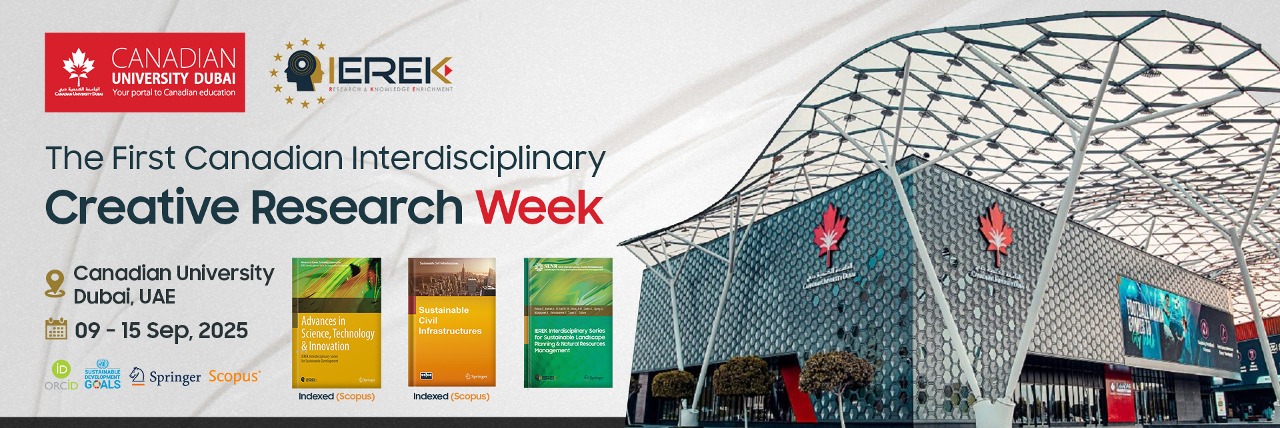
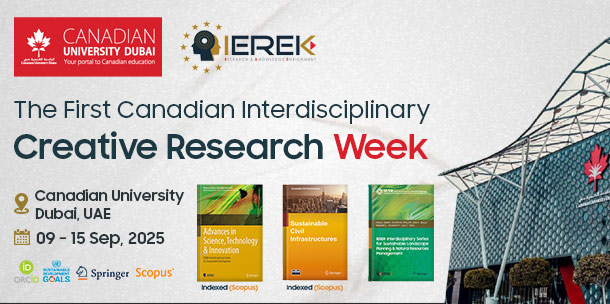

Professor/Dean of Research and Innovation at the Faculty of Management of Canadian University Dubai, United Arab Emirates.

Assistant Professor/Coordinator for HRM and Management at the Faculty of Management of Canadian University Dubai, United Arab Emirates.

Assistant Professor at the Faculty of Management of Canadian University Dubai, United Arab Emirates.
Subscribe to our newsletter
"The First Canadian Interdisciplinary Creative Research Week" is an event that brings together scholars, researchers, and professionals from diverse fields and disciplines. This week-long series of conferences is designed to encourage collaboration, spark innovation, and ignite intellectual curiosity across boundaries. With a focus on interdisciplinary research, the aim is to bridge the gaps between different fields, encouraging cross-pollination of ideas and the exploration of new perspectives. Throughout this exciting week, participants and attendees will have the opportunity to engage in discussions, attend insightful presentations, and collaborate on projects that go over traditional disciplinary boundaries. Held in collaboration with the Canadian University Dubai, the aim of the first interdisciplinary research week is to provide a platform for scholars and academics to discuss, present, and publish their academic endeavors.
The First Canadian Interdisciplinary Creative Research Week consists of six conferences:
Sustainable business development and circular economy have become increasingly important in today's world. With growing concerns about climate change, resource depletion, and environmental degradation, it is crucial for businesses to adopt sustainable practices that minimize their negative impact on the planet. Sustainable business development focuses on creating long-term value while considering social, environmental, and economic factors.
For the Sustainable Business Development and Circular Economy conference details click Here.
Architecture, creative design, engineering, and green infrastructure play a vital role in shaping our built environment and creating sustainable and livable spaces. Architecture combines art, science, and technology to design functional and aesthetically pleasing structures that mesh with their surroundings. Creative design adds a touch of innovation, ensuring that spaces are not only functional but also visually captivating. Engineering brings these designs to life, ensuring structural integrity, safety, and efficiency. Green infrastructure focuses on integrating natural elements and sustainable practices into the built environment, promoting biodiversity, improving air and water quality, and mitigating the impacts of climate change. Together, these disciplines work to create spaces that are not only visually appealing but also environmentally responsible, enhancing the quality of life for communities and fostering a sustainable future.
For the Architecture, Creative Design, Engineering, and Green Infrastructure conference details click Here.
Mass communication and digital transformation have become increasingly important in our world. Mass communication enables the dissemination of information and ideas on a large scale, allowing for the exchange of knowledge and shaping public opinion. It plays a crucial role in promoting democratic societies and social change, and facilitating cultural understanding. Overall, the combination of mass communication and digital transformation has the potential to shape our society, empower individuals, and drive positive change in an increasingly digital world.
For the Mass Communication and Digital Transformation conference details click Here.
Environmental resilience, liveability, and public health are interconnected and crucial aspects of creating sustainable and thriving communities. By building resilience, we can protect our natural resources, mitigate the impacts of climate change, and ensure the long-term well-being of our planet. Liveability encompasses the quality of life in a community, including access to amenities, green spaces, transportation options, and social infrastructure. It is essential for creating healthy, vibrant, and inclusive communities where people can thrive. Public health, on the other hand, focuses on promoting and protecting the health and well-being of individuals and communities. By prioritizing environmental resilience, liveability, and public health, we can create sustainable communities that are resilient to environmental challenges, promote well-being, and enhance the quality of life for all.
For the Environmental Resilience, Liveability, and Public Health conference details click Here.
Cultural, humanities, and social studies are important disciplines that contribute to our understanding of the human experience, encourage cultural appreciation, and promote critical thinking. The study of culture allows us to explore the rich diversity of human societies, traditions, and values, fostering empathy and understanding across different cultures. Humanities subjects, such as literature, philosophy, and history, discuss the complexities of human existence and provide insights into our shared human condition. Social studies, on the other hand, examines the social, political, and economic structures that shape our societies. It helps humans understand the complexities of human behavior, social interactions, and societal issues, empowering them to become active and engaged citizens. Together, these disciplines enrich lives, broaden perspectives, and encourage a more inclusive and tolerant society. They remind us of our shared humanity, encourage dialogue, and contribute to the well-rounded development of individuals and communities.
For the Cultural, Humanities, and Social Studies conference details click Here.
The importance of sustainable creative industries cannot be overstated. These industries cover a wide range of fields, including fashion, design, film, music, art, and more. By incorporating sustainable practices, these industries can have a significant positive impact on the environment and society as a whole. Sustainable creative industries prioritize ethical sourcing, responsible production methods, and the use of environmentally friendly materials. They promote circular economy principles, reducing waste, and striving for resource efficiency. By embracing sustainability, these industries can lead by example, driving innovation, and setting new standards for a more environmentally conscious and socially responsible future. Additionally, sustainable creative industries have the potential to create economic opportunities, generate employment, and contribute to the overall well-being of communities.
For the Sustainable Creative Industries conference details click Here.
To read more, Click Here
To read more, Click Here
To read more, Click Here
To read more, Click Here
To read more, Click Here
To read more, Click Here

Sustainable business development and the adoption of a circular economy are of huge importance in today's world. These concepts recognize the need for businesses to operate in a manner that minimizes environmental impact, promotes social responsibility, and ensures long-term economic viability. By embracing sustainable practices, businesses can reduce their carbon footprint, conserve natural resources, and mitigate the negative consequences of climate change. Additionally, a circular economy encourages the efficient use of resources by promoting recycling, reusing, and repurposing materials throughout the production and consumption process. This shift towards a circular economy not only reduces waste but also creates new opportunities for innovation, job creation, and economic growth. Ultimately, sustainable business development and the circular economy are essential for creating a more resilient, equitable, and prosperous future for both businesses and society as a whole.
Conference Scope
The conference on Sustainable Business Development and Circular Economy aims to bring together leaders, researchers, practitioners, and policymakers from around the world to discuss and explore the latest trends, innovations, and challenges in sustainable business practices and the circular economy. The conference will provide a platform for sharing knowledge, insights, and experiences, with a particular focus on creating sustainable business models, promoting circular economy initiatives, and driving economic growth while minimizing environmental impact.
Statement of Purpose
The conference on Sustainable Business Development and Circular Economy aims to catalyze driving positive change and shaping the future of sustainable business practices and the circular economy. The purpose of this conference is to provide a platform for participants to explore the latest advancements, strategies, and best practices in sustainable business development and the circular economy. Through discussions, engaging presentations, and interactive sessions, and along with the published proceedings through the conference, the main goal of the conference is to facilitate the exchange of ideas, experiences, and research findings among participants and attendees, enabling them to deepen their understanding of sustainable business practices and circular economy concepts. In addition to encouraging collaboration and partnership between different stakeholders, including businesses, government agencies, nonprofits, and academic institutions. By connecting individuals and organizations from various sectors, the conference aims to push the idea of cross-sectoral collaboration to drive sustainable development and circularity at local, regional, and global levels and empower participants to take action and drive real change in their respective fields.
The conference starts with discussing the idea of the integration of sustainability into business models, incorporating environmental and social considerations into strategic planning, adopting a triple-bottom-line approach (people, planet, profit), developing sustainable business goals and targets, measuring and reporting on sustainability performance, in addition to social and environmental responsibility in business practices.
The conference then moves on to discuss circular design and product innovation, Extended Producer Responsibility and Product Life Cycle management, sharing economy and collaborative consumption models, product-as-a-Service (PaaS) and leasing arrangements, circular supply chain management and closed-loop systems, and waste-to-resource initiatives and industrial symbiosis.
This part of the conference discusses financing sustainable business initiatives, impact investing and socially responsible investing, green bonds and sustainable financial products, financial incentives for circular economy adoption, integration of environmental, social, and governance (ESG) considerations in investment, in addition to impact measurement and reporting.
This part of the conference discusses renewable energy and clean technology solutions, digitalization and data-driven sustainability, smart cities and sustainable urban development, technological advancements for resource recovery and recycling, sustainable technologies, challenges and opportunities in adopting sustainable technologies.
This part of the conference will get into the challenges and opportunities for sustainable development, the relationship between capacity building and knowledge transfer, sustainable entrepreneurship and social enterprises, inclusive business models for poverty reduction, ethical sourcing and fair trade practices in developing economies, adapting circular economy principles to the specific context of developing economies
This part of the conference discusses sustainability education and training programs, communication strategies for raising awareness, behavioral change towards sustainable practices, engagement of youth and future leaders in sustainability, government policies and incentives for sustainable business as well as international agreements and frameworks (e.g., UN Sustainable Development Goals)
This part of the conference explores strategic planning, cost management, Supply Chain management, quality management and environmental management.
This part of the conference discusses the interconnectedness of Circular Economy and SDGs, like circular economy and poverty alleviation (SDG 1), circular economy and sustainable consumption and production (SDG 12), circular economy and climate action (SDG 13), circular economy and responsible consumption and production (SDG 14 and 15), circular economy and sustainable cities and communities (SDG 11), as well as circular Economy and Industry, Innovation, and Infrastructure (SDG 9).
This part of the conference discusses the integration of sustainability aspects, transitioning to circular business models, the capabilities and needs of small and medium enterprises (SMEs), collaboration and partnerships, policy and regulatory frameworks, consumer awareness and behavior change, technological innovation and infrastructure, as well as access to markets and supply chains.
This part of the conference discusses Circular Economy in manufacturing energy, construction, agriculture, transportation, technology and electronics fashion and textiles and in healthcare.
In today's rapidly changing world, the need for sustainable and environmentally conscious approaches to architecture, design, and engineering has never been more crucial. Without Architecture, Creative Design, Engineering, and Green Infrastructure several problems might arise that stand in the way of sustainable development and the transition to a circular economy. Without proper planning and design, buildings and infrastructure projects may not optimize resource use, energy efficiency, and waste management. This can result in increased environmental degradation, including pollution, habitat destruction, and inefficient use of natural resources. The absence of creative design and engineering solutions can also limit innovation and hinder the development of sustainable technologies and practices. Furthermore, the lack of green infrastructure, such as parks, green spaces, and sustainable transportation systems, can lead to reduced quality of life, increased air pollution, and limited access to nature. Addressing these issues requires a focus on integrating sustainable design principles, promoting innovation, and implementing green infrastructure solutions to create a more sustainable and resilient built environment.
Conference Scope
The conference titled "Architecture, Creative Design, Engineering, and Green Infrastructure" aims to explore and discuss various approaches, practices, and ideas for creating sustainable built environments. This multidisciplinary conference will provide a platform for collaboration, knowledge sharing, and networking among individuals passionate about shaping a greener and more sustainable future. The conference will discuss a wide range of topics related to architecture, creative design, engineering, and green infrastructure. The scope of the conference includes but is not limited to, areas like sustainable design and construction, human-centric design and well-being, circular economy and resource management, innovative materials and technologies along with policy and regulations for sustainable built environments.
Statement of Purpose
As urbanization intensifies and the impacts of climate change become increasingly apparent, it is imperative to rethink traditional practices and embrace innovative solutions that prioritize the well-being of both people and the planet. This conference provides a unique platform for participants to engage in interdisciplinary discussions, share research findings, display best practices, and explore technologies and ideas in sustainable design and construction.
This part of the conference discusses integrating sustainability principles into architectural design, urban planning for sustainable and livable cities, sustainable building materials and construction techniques, energy-efficient and passive design strategies, designing for Circular Economy Principles, and promoting community resilience and social cohesion through design.
The conference explores parametric design and generative algorithms, data-driven design and smart buildings, virtual reality (VR) and augmented reality (AR) in architectural visualization, digital fabrication and additive manufacturing, sustainable design and energy analysis, along with digital representation and visualization techniques.
This part of the conference discusses advancements in structural engineering for sustainable buildings, renewable energy systems and integration into built environments, smart technologies for energy management and monitoring, resilient infrastructure design for climate change adaptation, building automation systems for energy optimization and water management and conservation in built environments.
This part discusses promoting circularity in architecture and design, green roofs, walls, and urban green spaces, sustainable transportation and mobility solutions, water management and conservation in built environments, sustainable materials and technologies for green infrastructure and circular economy approaches to waste management.
This part of the conference handles Biophilic design and its impact on human health and well-being, universal design for inclusive and accessible spaces, human-centered approaches to urban planning and architecture, enhancing occupant comfort and productivity through design, social interaction, and community well-being in addition to the Impact of the built environment on psychological well-being.
Discusses community engagement and participatory design processes, social equity and affordable housing in sustainable development, regenerative design and the integration of nature into communities, sustainable transportation and smart city initiatives, resilient community design and climate change adaptation, and community-based renewable energy systems.
Handles discussions on government policies and regulations for sustainable architecture and infrastructure, Net-zero energy and green building certifications, funding mechanisms and financial incentives for sustainable projects, cross-sector collaborations for sustainable urban development green Procurement, and sustainable public infrastructure policies along with urban planning and zoning regulations for sustainability.
This part of the conference explores advancements in eco-friendly and recyclable building materials, energy-efficient lighting and smart building systems, digital design tools and building information modeling (BIM), sustainable waste management and recycling in construction, sustainable façade systems and building envelopes and advanced building materials for sustainable construction.
This part handles integrated approaches to sustainable infrastructure planning, green infrastructure and nature-based solutions, resilient infrastructure design and climate change adaptation, life cycle assessment and sustainable infrastructure, smart infrastructure and digitalization along with social equity and community engagement in infrastructure planning.
This part of the conference handles AI in architectural design, AI-driven generative design, AI-enabled digital fabrication, AI and augmented reality (AR) in design visualization, AI for sustainable design, and ethical considerations of AI in design.
This part of the conference explores Explainable AI (XAI), machine-learning algorithms for textual data, reinforcement learning, ethical considerations in machine learning and AI, machine learning trends and innovations, deep learning, and neural networks In addition to AI engineering and DevOps.
This part of the conference discusses parallel computing architectures, parallel algorithms and models, distributed computing, and cluster computing. High-performance computing applications, performance optimization and benchmarking, programming models, and tools, in addition to big data and high-performance computing.
This part discusses image acquisition and formation models, image processing concepts, feature extraction and selection, object detection and recognition, motion estimation and tracking, image classification and segmentation in addition to applications of computer vision.
This part of the conference handles software development life cycle (SDLC), software testing, and quality assurance, software design and architecture, software requirements engineering, software project management, software maintenance and evolution along with software engineering ethics and professionalism.
This part of the internet is responsible for the IoT and embedded systems overview, it also discusses IoT applications and use cases, embedded systems design for IoT, IoT connectivity and communication protocols, IoT data processing and analytics, IoT security and privacy, and embedded systems development and tools.
This part of the conference discusses big data analytics in smart healthcare systems, the impact of big data analytics on marketing strategy, data science and big data analytics in various domains, data science and big data analytics in IoT and embedded systems, data science and big data analytics in decision making in addition to data science and big data analytics training and education.
This part of the conference discusses integrated circuit design, semiconductor technologies, analog and digital circuits, VLSI design and System-on-Chip (SoC), circuit simulation and verification, power electronics, and energy conversion in addition to emerging trends in electronics.
This part of the conference handles discussions on Wide Bandgap Semiconductor Devices, renewable energy systems, and electric vehicle power conversion circuits, maximum power point tracking for Photovoltaic Systems, power electronic circuit design and modeling, power electronics for energy storage systems in addition to artificial Intelligence for power electronics and energy systems.
The importance of Mass Communication and Digital Transformation cannot be overstated in today's interconnected and rapidly evolving world. Mass communication plays a crucial role in disseminating information, encouraging dialogue, and shaping the public opinion. It enables the exchange of ideas, knowledge, and perspectives on a global scale, breaking down barriers and connecting people from diverse backgrounds. Moreover, digital transformation has revolutionized the way we live, work, and communicate. It has enhanced efficiency, productivity, and connectivity across various sectors, enabling seamless collaboration, innovation, and access to information. Digital transformation has also democratized opportunities, providing individuals and communities with access to education, healthcare, e-commerce, and other essential services. Furthermore, it has paved the way for sustainable practices, enabling organizations to streamline processes, reduce paper waste, and mitigate their environmental impact. Mass communication and digital transformation empower individuals, drive economic growth, and encourage inclusive and sustainable development in our increasingly interconnected world.
Conference Scope
The aim of the conference on Mass Communication and Digital Transformation is to bring together academics, researchers, industry professionals, and policymakers to explore the intersection of mass communication and ongoing digital transformation. This conference provides a platform for participants to discuss and share insights on the challenges, opportunities, and implications arising from the rapid advancements in digital technologies within the field of mass communication. The conference handles topics such as Digital Transformation in Journalism and News Media, New Media Platforms and Technologies, Digital Transformation in Entertainment and Broadcasting, Digital Literacy and Media Education in addition to Regulatory Frameworks and Policy Considerations.
Statement of Purpose
In today's interconnected world, the field of mass communication is undergoing a profound transformation. The widespread influence of digital technologies has revolutionized the way information is disseminated, consumed, and produced. This conference aims to critically examine the dimensions of this digital transformation, discussing journalism, entertainment, broadcasting, education, and more.
The Mass Communication and Digital Transformation Conference is committed to providing an inclusive platform for scholars, professionals, and policymakers to explore the evolving landscape of mass communication in the era of digital transformation. The purpose of this conference is to facilitate meaningful discussions, share research results, and promote collaborations that contribute to a deeper understanding of the challenges and opportunities presented by the intersection of mass communication and digital technologies.
This part of the conference discusses the impact of digital platforms on mass communication, social media's influence on information dissemination, digital journalism and the future of news reporting, ethical challenges in the digital media landscape, digital media and political communication as well as the role of online platforms in mass communication.
This part of the conference explores Innovations in digital marketing strategies, data-driven advertising and personalized marketing, the role of social media influencers in digital advertising, challenges and opportunities in the digital advertising ecosystem, measurement and analytics in digital advertising, along with customer experience and digital transformation in advertising.
This part of the conference discusses online journalism and the shifting media landscape, citizen journalism and user-generated content, data journalism and the use of analytics in news reporting, fake news, disinformation, and combating misinformation online, trust and credibility in the digital news era in addition to evolving newsroom practices and digital workflows.
This part of the conference discusses emerging technologies in mass communication, virtual and augmented reality in media production, podcasting and the rise of audio content, artificial intelligence in content creation and curation, live Streaming and real-time communication, as well as user-generated content and participatory media.
This part of the conference handles the idea of streaming platforms and the future of television, the convergence of media and entertainment industries, transmedia storytelling and audience engagement, the impact of digital platforms on traditional broadcasting models, data analytics and personalization in entertainment in addition to social media and influencer marketing in entertainment.
This part of the conference discusses promoting digital literacy for media consumers, media literacy education for children and young adults, ethical considerations in digital media consumption, media literacy in the era of disinformation and fake news, digital citizenship and online safety, along with digital literacy and critical thinking.
This part of the conference handles the idea of balancing freedom of expression with responsible digital communication, as well as cybersecurity and privacy concerns in the digital age, government regulations and policies for digital media platforms, intellectual property rights and content ownership in the digital realm, regulatory frameworks for financial technology (Fintech) in addition to regulatory considerations for emerging technologies.
This part of the conference discusses social media and influencer marketing, virtual and augmented reality in mass communication, artificial intelligence and automation in media, data analytics and audience insights, mobile journalism and citizen reporting, podcasting and audio content, in addition to virtual events and live streaming.
This part of the conference explores the principles of responsible journalism, media laws and ethical guidelines, balancing freedom of speech and responsibility, reporting on sensitive issues, media accountability and fact-checking, ethical dilemmas in journalism, along with media literacy and responsible consumption.
This part of the conference discusses media literacy skills, digital citizenship skills, online safety and civic engagement, teaching strategies and lesson plans, media literacy and democracy, and digital citizenship and character education.
This part of the conference discusses the role of mass communication in social change, media representations and social change, media activism and advocacy, media literacy and empowering communities, as well as new media technologies and social movements, media regulation and social change.
Environmental resilience, livability, and public health cannot be of more importance in today's world. Environmental resilience states the capacity of ecosystems and communities to withstand and recover from environmental shocks and stresses, such as climate change, natural disasters, and pollution. It is crucial because a resilient environment ensures the sustainability of ecosystems, promotes biodiversity and safeguards essential ecosystem services that support human well-being.
Livability, on the other hand, focuses on creating cities and communities that contribute to a high quality of life. This includes factors such as access to green spaces, clean air, safe and walkable neighborhoods, efficient transportation systems, and social amenities. A livable environment enhances physical and mental well-being, promotes social cohesion, and stresses the importance of the presence of a sense of belonging and pride within communities.
Public health is intricately linked to both environmental resilience and livability. A healthy environment is a foundation for a healthy population. Environmental factors, such as air and water quality, exposure to pollutants, and access to safe and nutritious food, significantly impact public health outcomes. By prioritizing environmental resilience and livability, we can mitigate environmental risks, reduce pollution, enhance access to clean resources, and create healthier environments that support the physical, mental, and social well-being of individuals and communities.
The importance of environmental resilience, livability, and public health lies in their interdependence and the profound impact they have on human well-being and the sustainability of our planet. By prioritizing these aspects, we can create a healthier, more resilient and sustainable future for future generations and ourselves.
Conference Scope
The conference titled "Environmental Resilience, Livability, and Public Health" aims to bring together researchers, practitioners, policymakers, and stakeholders from many fields to discuss and explore the interconnections between environmental resilience, livability, and public health. The conference will address the complex environmental challenges that impact the well-being of communities and individuals. The scope of the conference includes a range of topics related to environmental resilience, livability, and public health like Environmental Resilience, Livability and Urban Planning, Public Health and Environmental Factors, Disaster Preparedness and Emergency Response, Sustainable Development and Environmental Resilience, Community Engagement, and Collaboration.
Statement of Purpose
The main aim of the conference titled "Environmental Resilience, Livability, and Public Health" is to create a platform for researchers and practitioners to come together and address the intricate relationship between environmental resilience, livability, and public health. The purpose of this conference is to encourage interdisciplinary collaboration, exchange of knowledge, and the generation of innovative ideas to tackle the pressing environmental challenges that impact the well-being of communities and individuals.
This part of the conference discusses strategies for adapting to climate change and building resilient communities, mitigation measures to reduce greenhouse gas emissions and promote sustainability, assessing and managing climate-related risks and vulnerabilities, the role of nature-based solutions in enhancing environmental resilience, sustainable urban planning and design, climate change and public health.
Discusses urban planning and design for livability and well-being, sustainable transportation systems and infrastructure development, access to green spaces, parks, and recreational facilities in urban areas, promoting social equity and inclusivity in urban development, access to basic services and amenities, participatory planning and community engagement.
This part of the conference discusses the idea of understanding the links between environmental factors and health disparities, addressing environmental injustices and their impact on public health, promoting equitable access to clean air, water, and healthy food, community engagement and empowerment in environmental decision-making, environmental health education and awareness, and international perspectives on environmental justice.
This part of the conference discusses assessing the health risks associated with environmental pollution and contaminants, air pollution and respiratory health, it also discusses evaluating the health benefits of green spaces and nature exposure, integrating environmental health considerations into public health policies and programs, the impact of chemicals and toxins on public health, climate change and infectious diseases.
This part of the conference explores the ideas of balancing economic development and environmental sustainability, promoting sustainable consumption and production patterns, circular economy approaches and waste management strategies, sustainable agriculture and food systems for improved public health and environmental resilience, green buildings and sustainable infrastructure as well as biodiversity conservation and ecosystem restoration.
Discusses enhancing resilience to natural disasters and extreme weather events, effective emergency response planning and coordination, integrating public health considerations into disaster risk reduction strategies, building community resilience and capacity for disaster response and recovery, evacuation and sheltering strategies in addition to emergency medical response and healthcare systems.
This part of the conference discusses technological advancements and innovations for environmental monitoring and risk assessment, data-driven approaches for assessing and managing environmental health risks, harnessing digital technologies for promoting public health and environmental well-being, collaborative approaches and partnerships for addressing complex environmental challenges, innovative approaches to environmental education and awareness In addition to sustainable agriculture and food systems innovations.
This part of the conference discusses the sustainable development goals (SDGs), international environmental agreements, cross-border collaboration for environmental conservation, public-private partnerships for sustainable development, indigenous knowledge and sustainable development, technology transfer and capacity building, along with financing mechanisms for sustainable development.
This part of the conference discusses climate change impacts and vulnerability assessment, adaptation strategies and resilience planning, mitigation measures and climate action, climate resilient Infrastructure and built environment, natural resource management and conservation, community engagement and social resilience and climate Information and Early Warning Systems.
This part of the conference discusses the different types of energy like Solar Energy, Wind Energy Hydropower, Biomass and Bioenergy, Geothermal Energy, it also discusses energy storage and grid integration, sustainable transportation.
This part of the conference handles physicochemical remediation methods, sustainable remediation practices, hazardous waste management, soil and water reclamation, emerging technologies for remediation, environmental impact assessments, in addition to risk assessment and remediation strategies.
This part of the conference discusses the importance of biodiversity conservation, protected areas and conservation strategies, threats to biodiversity, conservation genetics and species management, ecosystem restoration and resilience, indigenous knowledge and traditional practices along ith connectivity and landscape conservation.
This part of the conference explores transit-oriented development, green building and sustainable architecture, urban heat island mitigation, sustainable infrastructure systems, community engagement and participatory planning, resilient urban design and climate adaptation as well as sustainable transportation planning.
This part of the conference discusses participatory decision-making, community-based adaptation, social equity and inclusivity, knowledge sharing and capacity building, community-led disaster risk reduction, social networks and community cohesion along with collaborative governance and partnerships.
Sustainable creative industries play a vital role in supporting economic growth, cultural preservation, social development, and environmental sustainability. These industries cover a large range of sectors, including arts, design, media, fashion, film, music, architecture, and more. They not only contribute to the economy but also shape and reflect our cultural identities, allowing for the expression of diverse perspectives. Sustainable creative industries have the potential to drive economic growth and generate employment opportunities. They contribute to job creation, entrepreneurship, and the development of new markets. By supporting and investing in these industries, governments and policymakers can stimulate economic activity, attract tourism, and generate revenue through exports and cultural products. Sustainable creative industries also play a crucial role in preserving and promoting cultural heritage, traditions, and diversity. They provide a platform for artists and cultural practitioners to showcase their unique skills, knowledge, and creativity. By preserving and promoting cultural expressions, sustainable creative industries help communities maintain a sense of identity, pride, and connection to their heritage. Creative industries enhance well-being by providing opportunities for personal expression, emotional connection, and cultural enrichment. They contribute to the overall quality of life by offering avenues for leisure, entertainment, and personal growth.
Conference Scope
The conference on Sustainable Creative Industries aims to bring together professionals, scholars, and industry practitioners from a wide range of creative sectors to explore and discuss the intersection of sustainability and creativity. This conference seeks to examine innovative approaches, best practices, and transformative ideas that promote sustainability within the creative industries. It will provide a platform for participants to share their research, experiences, and insights on sustainable manufacturing, production, design, and business models in the creative fields. The conference will cover topics such as sustainable materials, circular economy, renewable energy, waste reduction, ethical sourcing, responsible consumption, and social impact in the context of creative industries.
Statement of Purpose
Our goal is to inspire and empower participants to embrace sustainable solutions that not only minimize environmental impact but also promote social responsibility and economic viability. By examining topics such as sustainable manufacturing, responsible consumption, circular economy, ethical sourcing, and energy efficiency, we aim to showcase the power of creativity in driving positive change and creating a more sustainable future. Through engaging keynote speeches, panel discussions, and interactive workshops, the conference aims to inspire positive change, fostering a collaborative and forward-thinking community committed to making the creative industries more sustainable. Participants will have the opportunity to network and contribute to the development of strategies and solutions that drive the sustainable transformation of the creative industries.
The conference will start by discussing the digital transformation in creative industries, sustainable design and technology, virtual reality (VR) and augmented reality (AR) in creative industries, artificial intelligence (AI) and machine learning in creative industries, data analytics and creative decision-making as well as the Internet of Things (IoT) and smart technologies in creative industries.
The conference will then move on to discuss ecosystem restoration and conservation in creative practices, sustainable design inspired by nature, circular economy and sustainable production in creative industries, nature-based solutions for climate change adaptation, nature-based solutions for sustainable fashion and textiles and nature-based solutions in film, media, and entertainment.
This part of the conference discusses environmental art installations, street art and graffiti as tools of environmental activism, performance art and activism, photography and documentary films for environmental activism, community-based art projects for environmental activism in addition to art and design for sustainable advocacy.
This part of the conference discusses circular economy models in creative industries, social enterprise and impact investing in creative industries, collaborative and cooperative business models in creative industries, digital transformation and online platforms for sustainable creative businesses, cultural and creative tourism as a sustainable business model, in addition to sustainable Supply Chains and ethical sourcing in creative industries.
This part of the conference handles impact investing in sustainable creative ventures, crowdfunding for sustainable creative projects, venture capital and angel investment in sustainable creative startups, grants and funding programs for sustainable creative initiatives, social enterprise models for sustainable creative ventures as well as sustainable business loans and financing options for creative entrepreneurs.
This part of the conference discusses green building and sustainable architecture, zero waste initiatives, energy efficiency and renewable energy, sustainable transportation and mobility solutions, sustainable agriculture and food systems, in addition to environmental education and awareness.
This part of the conference explores the idea of sustainable food systems and waste reduction, renewable energy technologies and solutions, circular economy and resource efficiency, smart cities and sustainable urban development, water conservation and sustainable water management, and social innovation for sustainability.
This part of the conference gets into sustainable manufacturing processes and technologies, green materials and sustainable sourcing, sustainable supply chain management, life cycle assessment and product stewardship, green packaging and sustainable logistics, as well as the policy and regulatory frameworks for sustainable manufacturing.
This part of the conference discusses the importance of cross-sector collaboration and the barriers to cross-sector collaboration, models and frameworks for cross-sector collaboration, the benefits and outcomes of cross-sector collaboration, enablers of successful cross-sector collaboration, cross-sector collaboration for Sustainable Development Goals (SDGs) in addition to building collaborative innovation ecosystems.
This part of the conference discusses art as a catalyst for social change, community-based arts initiatives, creative placemaking, art for social justice, arts education and youth empowerment, creative entrepreneurship for social impact and collaborative partnerships for community engagement.
The registration fee does not cover accommodation or travel expenses. A list of accommodation options can be suggested by our team if available. Please contact [email protected] for inquiries.
We recommend that all authors take advantage of the benefits that IEREK offers, including various attendance types, publishing opportunities, and opportunities for discounts and waivers.
We are pleased to inform all applicants that they can use their previous publications to register for an IEREK membership, which offers a special discount.
IEREK offers a special discount to applicants from collaborative universities that have signed an MoU with IEREK to host or co-host one of its conferences.
IEREK also provides special discounts to authors from low and medium-income countries.
IEREK offers many alternative venues for publication. All accepted submissions to the conference, after a rigorous double-blinded peer-review process by the respective and highly-distinguished Editorial Board, will be published through one of the following venues:
Selected papers (according to the preference of the author) will be published in one of the Scopus-indexed or Web of Science-indexed book series or through related journal special issues. See the publishing opportunities section.
Accepted papers (according to the preference of the author) will be published through the Springer book series or through a special issue in one of the IEREK press open-access Journals.
IEREK offers many types of registrations that are diverse in registration fees; applicants can choose the type they are familiar with as follows:
Participants who are PhD holders, post-doctoral researchers, and universities’ affiliated professors and experts in the field.
Must provide proof of enrollment in a university by providing an enrollment certificate and/or a valid university ID (with issue/expiry date) etc.
Participants who are not affiliated with universities such as practitioners, policymakers, entrepreneurs, etc.
Have access to the event to enjoy the discussions, coffee breaks, and lunch as a co-author or audience.
An author may need to attend the conference for presentation only to present a research idea without publication or full paper submission; the fee in this case will be decreased.
| Type of Registration | Early Payment Deadline 20 Mar 2025 |
Regular Payment Deadline 30 May 2025 |
Late Payment Deadline 15 Jul 2025 |
|---|---|---|---|
| Scopus indexed-ASTI Book by Springer | |||
| Student | 350 € | 400 € | 450 € |
| Academic | 400 € | 450 € | 500 € |
| Professional | 450 € | 500 € | 550 € |
| Co-author/ Audience | 200 € | 250 € | 300 € |
| SLNR Book by Springer | |||
| Student | 300 € | 350 € | 400 € |
| Academic | |||
| Professional | |||
| Co-author/ Audience | 200 € | 250 € | 300 € |
| Open Access IEREK Press Journals | |||
| Student | 250 € | 300 € | 350 € |
| Academic | 300 € | 350 € | 400 € |
| Professional | 350 € | 400 € | 450 € |
| Co-author/ Audience | 150 € | 200 € | 250 € |
IEREK offers various types of participation. Applicants can apply for in-person attendance to benefit fully from conference discussions and knowledge exchange.
IEREK also offers virtual attendance for authors to present their research papers online; however, we strongly encourage all applicants to attend the conference in person.
Type 1:
Through IEREK – Springer Nature Interdisciplinary book series “Advances in Science, Technology, and Innovation” (ASTI). See previous publication here.
Type 2:
Through IEREK – Springer Nature Interdisciplinary book series “Sustainable Landscape Planning, and Natural Resources Management” (SLNR). See previous publication here.
The physical fee covers:
* Each research paper should have one main author who should pay the full fee (Author fees) regardless of attendance. Co-authors, each, have their fees to pay to attend the event. This applies to online attendance as well as physical attendance.
* A research paper fee allows only one author, whether main or co-author, to attend the conference and receive only one conference kit. Extras can be requested for an additional fee.
| Type of Registration | Early Payment Deadline 20 Mar 2025 |
Regular Payment Deadline 30 May 2025 |
Late Payment Deadline 15 Jul 2025 |
|---|---|---|---|
| Scopus indexed-ASTI Book by Springer | |||
| Student | 300 € | 350 € | 400 € |
| Academic | 350 € | 400 € | 450 € |
| Professional | 400 € | 450 € | 500 € |
| Co-author/ Audience | 100 € | 150 € | 200 € |
| SLNR Book by Springer | |||
| Student | 250 € | 300 € | 350 € |
| Academic | |||
| Professional | |||
| Co-author/ Audience | 100 € | 150 € | 200 € |
| Open Access IEREK Press Journals | |||
| Student | 200 € | 250 € | 300 € |
| Academic | 250 € | 300 € | 350 € |
| Professional | 300 € | 350 € | 400 € |
| Co-author/ Audience | 100 € | 150 € | 200 € |
IEREK offers virtual attendance, providing authors with a unique link to join the conference sessions and present their papers as per the announced program.
IEREK is dedicated to optimizing the benefits for each delegate so, similar to physical attendance, when it comes to virtual attendance IEREK also provides two venues for publication, which are:
Type 3:
Online attendance + Publication through Scopus and Web of Science indexation Through IEREK – Springer Nature Interdisciplinary book series “Advances in Science, Technology, and Innovation” ASTI, see previous publications here.
Online attendance + Publication through Scopus, Web of Science (SCImago), EI Compendex, zbMATH indexation Through Springer Nature Interdisciplinary book series, “Sustainable Civil Infrastructure” see previous publication here.
Type 4:
Online attendance + Publication through Springer Nature's new book series (to be indexed in Scopus soon). Through IEREK – Springer Nature Interdisciplinary book series” Sustainable Landscape Planning, and Natural Resources Management” SLNR.
Online attendance + Publication through Open-access IEREK press Journals, (to be indexed soon in Web of Science and afterward in Scopus).
The online fee covers:
* Each research paper should have one main author who should pay the full fee (Author fees) regardless of attendance.
* Co-authors, each, have their fees to pay to attend the event. This applies to online attendance as well as physical attendance.
* Participants can use only one type of discount opportunity, which meets their preferences.
* Authors should contact the conference manager through this email [email protected] to consider the discount and waiving for all the above cases so that the conference manager can provide an exclusive invoice for each case.
| Afghanistan, Algeria, Angola, Bangladesh, Benin, Bhutan, Bolivia, Burkina Faso, Burundi, Cabo Verde, Cambodia, Cameroon, Central African Republic, Chad, Comoros, Congo, Congo Dem. Rep., Côte d'Ivoire, Djibouti, Egypt, Eritrea, Eswatini, Ethiopia, Gambia, Ghana, Guinea, Guinea-Bissau, Haiti, Honduras, India, Iran, Jordan, Kenya, Kiribati, Kyrgyz Republic, Lao PDR, Lebanon, Lesotho, Liberia, Madagascar, Malawi, Mali, Mauritania, Micronesia, Mongolia, Morocco, Mozambique, Myanmar, Nepal, Nicaragua, Niger, Nigeria, Pakistan, Papua New Guinea, Philippines, Rwanda, Samoa, São Tomé and Principe, Senegal, Sierra Leone, Solomon Islands, Somalia, South Sudan, Sri Lanka, Sudan, Syria, Tajikistan, Tanzania, Timor-Leste, Togo, Tunisia, Uganda, Ukraine, Uzbekistan, Vanuatu, Vietnam, Yemen, Zambia, Zimbabwe |
IEREK has its own publications indexed in Scopus, Web of Science, Ei Compendex, and zbMATH. As a result, IEREK offers these publication opportunities with additional Article Processing Charges (APCs). Furthermore, IEREK dedicates significant efforts to collaborating with various closed-access journals to arrange special issues that align with the conference scope.
Should an author wish to expand their work for submission to the Q1 Journal MRSE, IEREK serves as the main contact for this journal and holds the authority to submit special issues. MRSE is an open-access journal, necessitating authors to cover the APCs. In this case, the author should reach out to the conference manager who will then liaise with the Editor-in-Chief of MRSE.
iDirect is a new and efficient platform that allows direct submissions of research papers across various fields of science. iDirect accepts and covers all fields of science, not only those related to a particular conference. Individual authors are encouraged to submit their research discussing new ideas and presenting solutions to everyday problems that fall under numerous scientific themes. The iDirect platform is integrated into the peer review system for online conferences. You can publish your work through iDirect without the need to attend the conference or adhere to any submission deadlines. iDirect accepts a wide range of disciplines, eliminating the need to align with the conference's specific theme or scope. Based on the scope of your research, we will identify the most relevant proceedings for publication. The editor will schedule a discussion with you to review your presentation before proceeding to the peer-review process. Learn more here!
IEREK puts a lot of effort into expediting the peer review process to publish articles as quickly as possible. This requires prompt responses from all authors to the editors' comments, if any. Your swift response is highly appreciated to advance the production process and get your articles online. We prioritize the first author to respond as per our formula. The conference proceedings will be divided into multiple books, with the first one scheduled for publication within 3 months after the conference date. We encourage all authors to aim for publication in the first release.
For participants who need Entry Visas to the country where the conference will be held, IEREK will issue the corresponding invitation letter for accepted applicants to facilitate visa issuance. Please notice that we will attempt to assist you in obtaining a visa but the responsibility is yours and the decision rests solely with the appropriate Embassy. For the requirements of issuing a visa letter please read more here!
| Title | Date |
|---|---|
| Abstract Submission Deadline | 15 Jan 2025 |
| Letter of Visa (for delegates who need visa entry) *payment required | 15 Mar 2025 |
| Last Notification for Abstract Acceptance & Approval to present | 30 Mar 2025 |
| Early Payment Deadline | 20 Mar 2025 |
| Regular Payment Deadline | 30 May 2025 |
| Late Payment Deadline | 15 Jul 2025 |
| Extended Abstract / Short Paper Submission Deadline | 15 Jun 2025 |
| Notification of acceptance/ rejection of submitted extended abstract/ short paper | 20 Jul 2025 |
| Conference Program | 09 Aug 2025 |
| Conference Launch | 09 Sep 2025 |
IEREK has an unyielding policy regarding plagiarism. We believe that copying/taking the ideas and work of other Authors without permission and credit is fraudulent. The Reviewing committee and IEREK employees have the authority to reject a paper during its reviewing process, based on the paper being subjected to either minor or major plagiarism.
Authors must refer to, and abide by, the following instructions in submitting their abstracts/ papers:
This is not a prerequisite for presenting your work at the conference. Meaning, you can present your submitted abstract without intending to publish your work.
This process can only be initiated after payment completion and confirmation:
Registration
To help the organizers plan for inter-disciplinary dialogue, participants are requested to choose from the conference themes/ Topics upon registration.
They must also refer to, and abide by, the following instructions in registering and submitting their abstracts/ papers:
Types of Participation
Organized from the comfort of your own home, the conference offers a virtual attendance option for your convenience. That said, participants will have a chance to present their abstract/research, online, and have their work considered for publication in the proceedings.
Virtual presenters are required to submit an abstract and extend this abstract following the “author instructions” below and before the deadline (see Important Dates). At least one author must pay the registration fee (see Registration & Fees).
For any reason, authors may wish to submit pre-recorded video presentations no later than 15 days prior to the conference. Alternatively, they may wish to record a voice-over PowerPoint presentation for submission to the conference organizers.
Organized at theCanadian University Dubai (CUD), United Arab Emirates, offering a Physical attendance option for your convenience. That said, participants will have a chance to present their abstract/research, on campus, and have their work considered for publication in the ASTI Series by Springer as part of the conference proceedings.
See Author Instructions and Registration & Fees for more information.
If your extended abstract (short paper) is accepted, it may be published in the conference proceedings book in the Advances in Science, Technology & Innovation Book Series by Springer (indexed in Scopus) even if you are not attending the conference. In this case, the accepted work will not be included in the final conference program and the fee will cover the cost of editorial handling and peer-review evaluation of your paper (See Author Instructions and Publishing Opportunities)
Non-presenting participants may also wish to attend the conference as Audience Members or Co-authors contributing to an already submitted abstract/ paper.
Attending a conference dramatically enhances both your professional and personal development. They help you sharpen the saw, meet and converse with industry experts, expand your resources and grow your professional network. IEREK Conference will help you:
1. Open Discussions: We bring together leading academic scientists, from different universities and countries, to exchange and share their experiences and research results.
2. Internationally Accredited Certificate: The participants are granted internationally recognized certificates acknowledged by IEREK, the University, and Partnering Organizations.
3. Publication: Selected high-quality manuscripts will be published, after peer review, in the Advances in Science, Technology & Innovation (ASTI) book series by Springer or by IEREK Press Journals, both of which are indexed in world-renowned databases.
4. Research Technologies: Conferences can expand your resources by providing a great opportunity to promote gathered information on new technologies related to your research.
5. Networking: You can engage with industry experts to discuss with them the very latest research projects they could be working on and increase your chances of collaboration in future projects.
6. Academic Reputation: Attending many conferences will make you a known figure in academic circles and an active member of the academic community.
7. Conference Abstracts Material: Delegates will receive the conference Abstracts book in digital format on a CD. Shipping fees may apply.
All accepted submissions to the conference, after a rigorous double-blinded peer-review process by the respective and a highly-extinguished Editorial Board, will be published in one of the following:
 Advances in Science, Technology and Innovation (ASTI), an IEREK Interdisciplinary book series published by Springer Nature. (Scopus indexed)
Advances in Science, Technology and Innovation (ASTI), an IEREK Interdisciplinary book series published by Springer Nature. (Scopus indexed) About ASTI
Advances in Science, Technology & Innovation (ASTI) is a series of peer-reviewed books based on important emerging research that redefines the current disciplinary boundaries in science, technology and innovation (STI) in order to develop integrated concepts for sustainable development. It not only discusses the progress made towards securing more resources, allocating smarter solutions, and rebalancing the relationship between nature and people, but also provides in-depth insights from comprehensive research that addresses the 17 sustainable development goals (SDGs) as set out by the UN for 2030.
The series draws on the best research papers from various IEREK and other international conferences to promote the creation and development of viable solutions for a sustainable future and a positive societal transformation with the help of integrated and innovative science-based approaches. Including interdisciplinary contributions, it presents innovative approaches and highlights how they can best support both economic and sustainable development, through better use of data, more effective institutions, and global, local and individual action, for the welfare of all societies. The series particularly features conceptual and empirical contributions from various interrelated fields of science, technology and innovation, with an emphasis on digital transformation, that focus on providing practical solutions to ensure food, water and energy security to achieve the SDGs. It also presents new case studies offering concrete examples of how to resolve sustainable urbanization and environmental issues in different regions of the world. Read More.
The ASTI series is fully indexed in Scopus and any chapter/ paper published as part of this series will be seen on the Scopus database. Some titles have been successfully indexed or submitted for indexation in Web of Science (ISI).
About SLNR
Sustainable Landscape Planning and Natural Resources Management (SLNR) is a peer-reviewed book series that presents groundbreaking research through the intersection of two main areas that of which are ‘Sustainable Landscape Planning’ and ‘Natural Resources Management’. The series initially covers a wide range of academic disciplines in sustainability, including landscape ecology, green urbanism, urban regeneration, land restoration and renaturation, energy management, and nature conservation. Moreover, it also incorporates the latest developments and research in engineering topics that contribute to more sustainable cities, such as Geosciences, infrastructure, civil engineering, geology, mining, water, and natural resources conservation and management.
By showcasing methods for discovering, managing, and employing natural resources, the series aims to provide approaches that enable the responsible use of these resources. Ultimately, the SLNR series is committed to advancing the United Nations' Sustainable Development Goals for 2030. Read More.
 IEREK Press Journals, a multidisciplinary publisher that aims to cultivate and disseminate research.
IEREK Press Journals, a multidisciplinary publisher that aims to cultivate and disseminate research.
ESSD is a peer-reviewed, scholarly journal that aims to systematically develop the research-driven curiosity and evidence-based discourse of aspiring scholars that seek to contribute to the academic community. As the world is currently living in an age of information where sources are widely available on the Internet, we at ESSD seek to efficiently utilize the available information to help create robust and evidence-based knowledge. In the process, we offer researchers, in general, and young and aspiring ones in particular a quicker way to get their work published and gain exposure through online open access. We pride ourselves on getting submitted work to be published quickly, through the use of our worldwide pool of subject specialist peer reviewers. Find out more about ESSD International Journal here.

ARChive is an open-access journal that publishes conference proceedings on a wide range of topics relating to social sciences. Consequently, it accepts original research papers on a wide spectrum of subjects. ARChive is a journal published on behalf of researchers that perpetually make an effort to contribute to their fields and provide them with high visibility of research submitted. The series publishes, both, theoretical and experimental high-quality papers of current and perpetual interest. It serves to cultivate, propagate, and essentially archive academic research that has been authored and submitted for academic conferences.
Find out more about ARChive International Journal here.

Resourceedings is an open access journal that publishes conference proceedings. Conference proceedings compromise of different disciplines, ranging from Engineering including built environments, architecture, and sustainability. Disciplines also include Technology and Energy. Resourceedings is a journal that publishes research articles that shed light on different crucial issues in order to provide them with solutions and suggestions. The journal publishes articles submitted by researchers of interest in different fields.
Find out more about Resourceedings International Journal here.
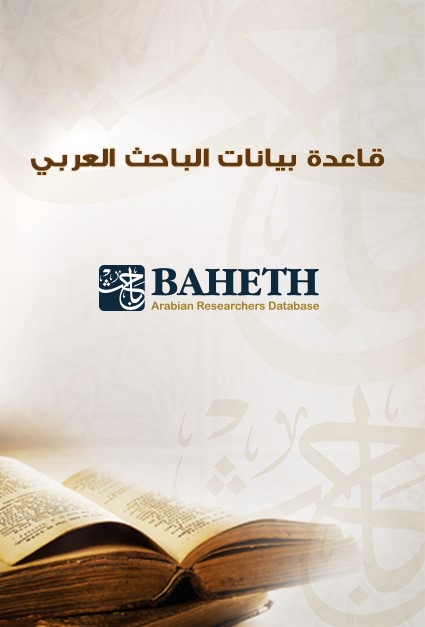
“BAHETH” in Architecture, Engineering, and Technology, is a peer-reviewed journal that publishes original academic research in the fields of Architecture, Engineering, and Technology. The journal welcomes research in the Arabic Language with an English Abstract. Papers submitted to this journal in Arabic must be presented in the English Language in the conference.
Find out more about BAHETH International Journal here.
To secure a tourist visa for the UAE, reach out to either a UAE-based airline, a tour agency, or a hotel where you plan to stay. They will facilitate the visa application process on your behalf with the official visa-issuing authorities in the UAE.
The United Arab Emirates is a federation made up of seven emirates located in the Arabian Peninsula's southeast: Abu Dhabi, Dubai, Sharjah, Ajman, Umm Al-Quwain, Fujairah, and Ras Al Khaimah. Since its inception in 1971, the UAE now boasts the Middle East’s third-largest economy, boasting an impressive GDP of $415 billion. Accordingly, the federation developed modern infrastructure and now houses everything from architectural masterpieces, to sky-rise buildings, museums, and other touristic attractions. As well as having stunning beaches and great weather all year round. As a matter of fact, Dubai became the world's second-most visited city right after Paris, France in 2022.
With a rich and vibrant history, the UAE has everything from archaeological sites to luxury hotels, stunning mosques, and shopping malls. There are plenty of places to go in both Dubai and Abu Dhabi.
Sheikh Zayed Grand Mosque Center
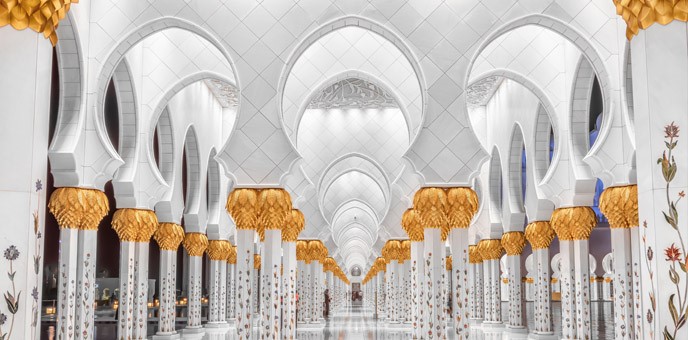
Named after the late UAE founding father and president, Sheikh Zayed bin Sultan Al Nahyan, the architectural masterpiece is one of the largest mosques in the federation and is the third-largest mosque in the world. The mosque is covered with marbled halls filled with breathtaking gold accents. Made by architects the world over, the mosque accommodates up to 50,000 worshippers each day and is open to visitors from Saturday to Thursday from 9:00 AM to 10:00 PM.
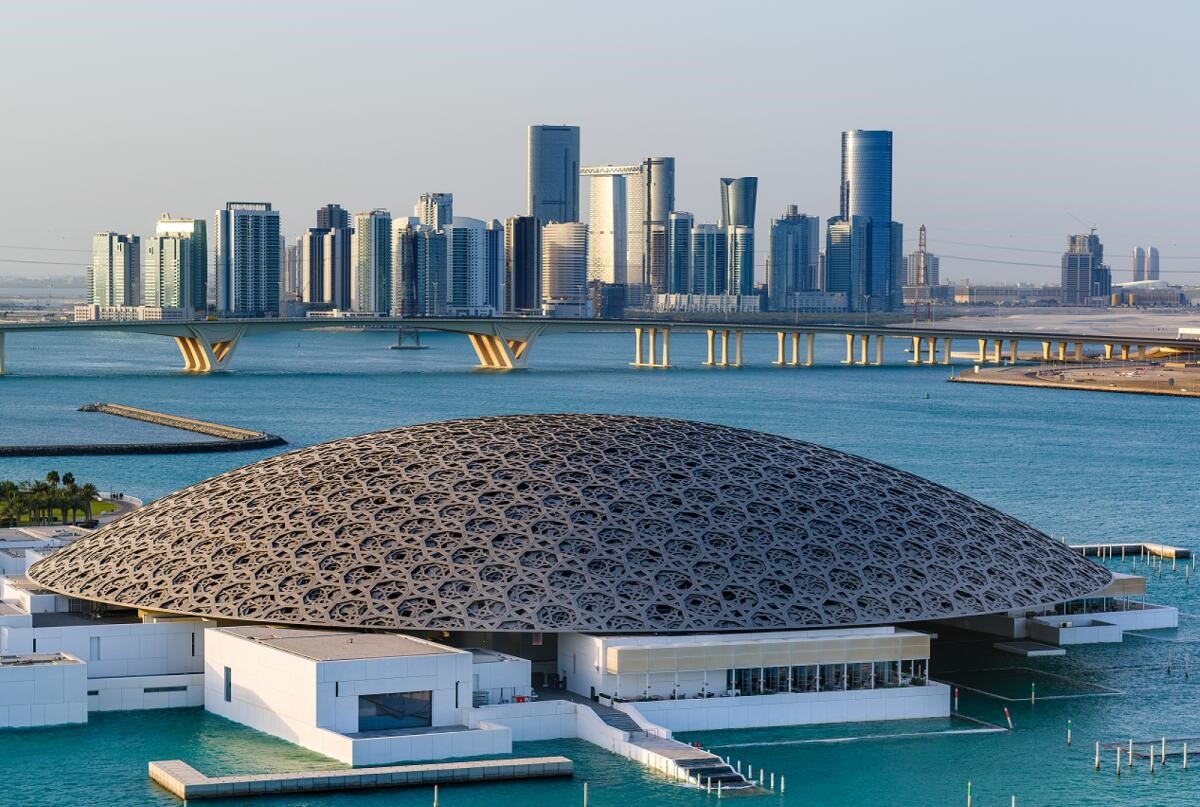
Louver Abu Dhabi Museum
Located on Saadiyat Island, Abu Dhabi, the Louver Abu Dhabi Museum was born in 2007, out of a cultural collaboration between France and the UAE. The collaborative effort brings both the UAE’s definite and long-term goals for creating cultural dialogue, exchange, and progress with France’s knowledge and ingenuity in the world of art and museums. In fact, the eye-catching dome exterior was designed by French architect Jean Nouvel and blends both Arabic heritage with French architectural design. The louver Abu Dhabi aims to be a universal museum in the Arab world, showcasing stories of human creativity and ingenuity from different cultures, civilizations, and time periods. Accordingly, galleries are not geographically separated but instead arranged in chronological order, connecting and blending the cultures of the past with the present day. The aim is for the visitors to harbor respect and curiosity towards other cultures and encourage learning as well as open-mindedness.
Campus Location
The Canadian University Campus – is located in City Walk - Al Wasl - Dubai.

![]()
Dubai is a vibrant and modern city known for its stunning architecture, luxury shopping, and diverse attractions. Here are some places you might consider visiting in Dubai:
Burj Khalifa: The world's tallest building, offering breathtaking views of the city from its observation decks.
The Dubai Mall: One of the largest shopping malls globally, featuring an extensive range of shops, restaurants, and entertainment options. It also houses attractions like the Dubai Aquarium and Underwater Zoo.
Burj Al Arab: A iconic, sail-shaped hotel that is often considered one of the most luxurious hotels in the world. While you may not stay there, you can visit some of its restaurants and bars.
Palm Jumeirah: A man-made island in the shape of a palm tree, featuring luxury resorts, private villas, and an array of dining and entertainment options.
Dubai Marina: A stunning man-made canal city with a range of restaurants, shops, and entertainment options. You can also take a boat tour or enjoy a walk along the promenade.
Dubai Fountain: Located outside the Burj Khalifa and Dubai Mall, the fountain is illuminated by lights and performs water dances set to music, creating a captivating spectacle.
Jumeirah Beach: A beautiful public beach with white sands and clear blue waters, offering a relaxing escape from the city's hustle and bustle.
The Dubai Miracle Garden: A breathtaking garden with a variety of colorful flowers arranged in creative displays. It's especially beautiful during the cooler months.
Dubai Opera: A world-class venue for performing arts, including opera, ballet, and concerts. The architecture itself is worth admiring.
Ski Dubai: Located in the Mall of the Emirates, this indoor ski resort allows you to experience winter sports in the middle of the desert.
Al Fahidi Historic District (Al Bastakiya): Dubai's historic district with narrow lanes, traditional wind-tower architecture, art galleries, and museums.
Dubai Creek: Take an abra (traditional boat) ride along Dubai Creek to experience the city's history and see the blend of old and new Dubai.
Dubai Frame: A modern architectural marvel offering panoramic views of both old and new Dubai.
Dubai Desert Conservation Reserve: If you're interested in desert experiences, you can take a desert safari to explore the dunes and enjoy traditional activities like camel riding and sandboarding.
Location: Dubai International Airport (DXB) is located in the Al Garhoud district, approximately 4.6 km east of Dubai city center.
Transport Options: Multiple transport options are available for travelers to reach their destinations in Dubai.
Location: Canadian University Dubai is located in the heart of Dubai, specifically on Sheikh Zayed Road, near the Dubai Mall and Burj Khalifa.
The distances between Ras Al Khaimah (RAK) and other emirates in the United Arab Emirates (UAE) vary, and travel times depend on factors such as traffic conditions and mode of transportation. Here are approximate distances and typical travel times by car:
- Availability: Taxis are readily available at DXB. You can find them at designated taxi ranks outside each terminal.
- Duration: The journey typically takes around 15-25 minutes, depending on traffic.
- Route: The Red Line of the Dubai Metro connects DXB to various parts of the city, including the vicinity of CUD.
- From Airport: You can board the Metro at either Airport Terminal 1 or Terminal 3.
- To CUD: Disembark at the Burj Khalifa/Dubai Mall station. From there, it is a short taxi ride or a 15-20 minute walk to CUD.
- Duration: The Metro ride from DXB to Burj Khalifa/Dubai Mall station takes about 25-30 minutes.
- Route: Several bus routes operate from DXB to various parts of Dubai. However, there is no direct bus service to CUD.
- Combination: You may need to take a bus from DXB to a central location like Deira or Bur Dubai and then transfer to another bus or taxi.
- Duration: The total travel time can vary significantly but generally takes 45 minutes to over an hour, depending on transfers and traffic.
- Services: Uber, Careem, and other ride-hailing services operate in Dubai and can be booked via their respective apps.
- Duration: Similar to taxis, the journey takes around 15-25 minutes.
Luggage: If you have significant luggage, taxis or ride-hailing services might be more convenient than public transport.
Peak Hours: Traffic can be heavy during peak hours (7-9 AM and 5-7 PM), so plan your journey accordingly.
Navigation: Using a map app or GPS can help in navigating the quickest routes and understanding traffic conditions.
With these transport options, reaching Canadian University Dubai from Dubai International Airport is straightforward, allowing students and visitors to transition smoothly to their destination.
Delegates in any event who cancel their registration due to special circumstances will receive refunds according to the following:
| Cancellation Policy | Up to 30 days before the event | 59 days before the event |
| Penalty | 20% | 100% |
A refund is not possible if
- An acceptance letter has been issued (Authors only)
- The proceedings of the event have been published (Authors only)
- A submitted manuscript is rejected by the editorial board after going through peer review.

ORCID, which stands for Open Researcher and Contributor ID, is a global, not-for-profit organization that aims to provide unique identifiers for authors, researchers, and scholars. ORCiD effectively eliminates duplication and errors regarding author names, affiliations, previous works, and all related academic data.
IEREK is a proud member of ORCiD, and we contribute directly to their initiative of clear and identifiable markers for researchers and scholars. As the first Egyptian partner to ORCiD in the organization’s history, we strongly believe that by utilizing ORCiD’s database and verification services, we become one step closer to achieving an accurate, and identifiable academic landscape.
We encourage our authors to input their ORCiD ID when registering for one of our conferences, submitting an abstract, or a full paper. By doing so, you directly link your research to your identity and affiliation and can showcase your various academic efforts all in one place. By Registering your ORCiD ID, you also increase your works’ visibility and provide easy access to your entire library of research and academic activity.
Click here to learn more about ORCiD, and here to register your ORCiD ID for free.




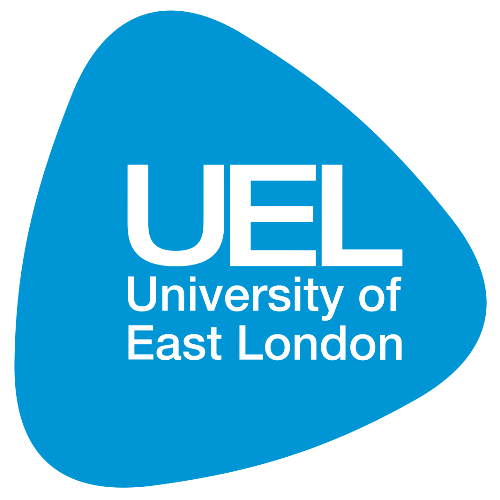







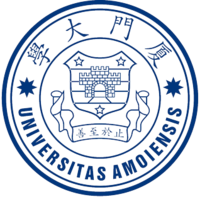

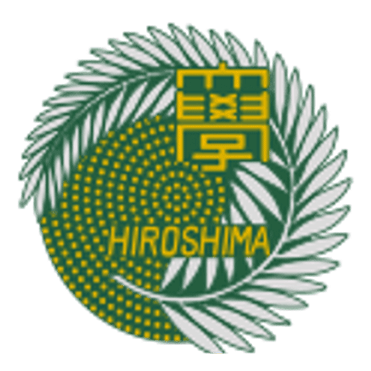
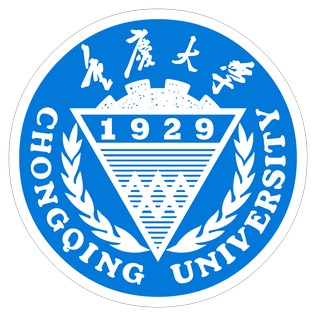
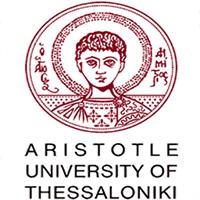
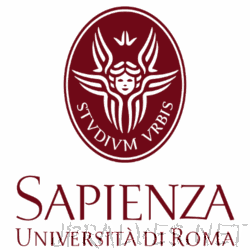
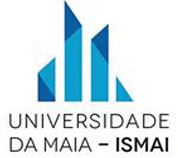



Professor/Dean of Research and Innovation at the Faculty of Management of Canadian University Dubai, United Arab Emirates.

Assistant Professor/Coordinator for HRM and Management at the Faculty of Management of Canadian University Dubai, United Arab Emirates.

Assistant Professor at the Faculty of Management of Canadian University Dubai, United Arab Emirates.
Subscribe to our newsletter
Join IEREK community
Cultural Studies, Humanities, and Social Studies
Cultural studies, humanities, and social studies are essential factors as they foster a deeper understanding of human cultures, promote critical thinking, analyze social dynamics, address public health challenges, encourage interdisciplinary collaboration, preserve cultural heritage , and engage in ethical reflection. They contribute to a well-rounded education and enable individuals to navigate a rapidly changing world with empathy, creativity, and a broader perspective.
The humanities, social studies, and cultural studies are vital for comprehending and negotiating the complexity of human cultures, societies, and personal experiences. Humanities and Cultural Studies offer a framework for researching and understanding various civilizations, customs, and viewpoints. They provide people the opportunity to broaden their perspective on the world and gain a deeper comprehension of the cultures and viewpoints of others. Studying the arts and social sciences also helps people develop critical thinking abilities by enabling them to examine, evaluate, and comprehend data from a variety of sources. It encourages originality and expands one's thinking, empowering people to tackle issues and obstacles with fresh ideas.
Social studies and cultural studies investigate the intersections of power, society, and culture. In order to shed light on the workings of social structures and systems, they examine social distinction, control, inequality, identity, media, and knowledge production.
Human beings’ comprehension of social studies and humanities advances their knowledge of culture, human behavior, and societal dynamics. The significance of these researches is demonstrated by the way they clarify the social determinants of health and aid in the understanding of how social, economic, and environmental factors affect public health outcomes.
Conference Scope
This conference welcomes contributions that discuss various topics within the realms of cultural studies, humanities, and social studies. The scope of the conference includes but is not limited to the following areas Cultural Studies, Cultural theory and analysis, Cultural diversity and identity, Intercultural communication, Popular culture and media studies, Cultural heritage and preservation, Literature and literary studies, Philosophy and ethics, Linguistics and language studies, Sociology and social theory, Political science and international relations, Psychology and human behavior and other related topics to the fields of cultural studies, humanities, and social studies.
The conference encourages the submission of original research papers, case studies, and theoretical frameworks that contribute to the advancement of knowledge and understanding in the fields of cultural studies, humanities, and social studies. Interdisciplinary approaches and themes are highly encouraged, as they facilitate a deeper understanding of the complex issues and challenges faced in these fields.
Statement of Purpose
The purpose of the Conference on Cultural Studies, Humanities, and Social Studies is to create a platform for intellectual exchange, collaboration, and exploration of the diverse and interconnected fields of cultural studies, humanities, and social studies. This conference aims to bring together researchers, academics, scholars, practitioners, and graduate students from around the world to foster a vibrant and inclusive space for the exchange of ideas, research findings, and innovative approaches.
The conference seeks to address the pressing issues and challenges faced in the fields of cultural studies, humanities, and social studies. It aims to facilitate critical discussions and provide a space for interdisciplinary exploration, recognizing that these fields are interconnected and contribute to a holistic understanding of human experiences, societies, and cultures.
Conference Topics
1. Cultural Heritage and Preservation:
The conference will start by discussing world heritage sites and preservation efforts, intangible cultural heritage, digital preservation of cultural heritage, cultural heritage and tourism, and preservation of cultural heritage in education in addition to challenges and ethics in cultural heritage preservation.
2. Interdisciplinary Approaches in Cultural Studies:
This part of the conference discusses the origins and evolution of cultural studies, interdisciplinary perspectives in cultural studies, cultural studies, and critical theory, methodological approaches in cultural studies, cultural studies and identity politics, along with cultural studies and media studies.
3. Cultural Diversity and Identity:
This part of the conference discusses cultural identity and self-perception, cultural diversity and social cohesion, cultural diversity and globalization, cultural diversity and the workplace, cultural diversity and media representation, in addition to cultural diversity and artistic expression.
4. Social Justice and Human Rights:
This part of the conference handles the topics of racial justice and equality, gender equality and women's rights, indigenous rights and land stewardship, access to education and equal opportunities environmental justice and sustainability along with disability rights and inclusion.
5. Digital Culture and Media Studies:
This part of the conference explores digital media and cultural transformation, media convergence and digital storytelling, social media and online communities, digital literacy and media education, digital media and cultural representation as well as digital media and creative expression.
6. Cultural Identity and Representation:
This part of the conference discusses stereotypes and misrepresentation in media, indigenous representation in media, intersectionality and cultural identity, media literacy and critical consumption, digital media and cultural representation in addition to cultural identity and global media.
7. Globalization and Cultural Exchange:
This part of the conference handles the topics of economic globalization, cultural diversity and coexistence, cultural exchange through travel and tourism, education and intercultural understanding, cultural appropriation vs. cultural exchange, and globalization and cultural conflict.
8. Popular Culture and Media Studies:
This part of the conference discusses cultural analysis of popular media, media representations and stereotypes, fan cultures and participatory media, popular culture and consumerism, social media and popular culture as well as globalization and popular culture.
9. Social Justice and Activism:
This part of the conference explores intersectionality and social justice, human rights and social justice, environmental justice and sustainability, racial justice and anti-racism, gender equality and feminist activism, along with disability rights and accessible activism.
10. Cultural Heritage and Preservation:
This part of the conference discusses archaeological preservation, cultural heritage conservation, indigenous cultural heritage, intangible cultural heritage, cultural heritage and identity in addition to digital preservation of cultural heritage.
11. Intersectionality and Identity Politics:
This topic is about understanding intersectionality, intersectionality and race, intersectionality and class, intersectionality and disability, intersectionality and indigenous identities as well as intersectionality and Politics.
12. Cultural Studies and Education:
This part of the conference discusses cultural diversity in education, critical pedagogy and cultural studies, media literacy and cultural studies, global perspectives in cultural studies, cultural studies and social justice education, in addition to culturally sustaining pedagogy.
13. Cultural Policy and Governance:
This topic explores cultural governance and urban hubs, democratization of culture and cultural democracy, collaboration and cooperation in cultural policy, cultural policy and funding, cultural policy and sustainability, and cultural policy and technology.
14. Literature, Language, and Linguistics:
This part of the conference discusses literary genres and movements, language acquisition and development, stylistics and literary analysis, translation studies, sociolinguistics and language variation, comparative literature, linguistic anthropology in addition to literary theory and criticism.
15. History and Memory:
This part of the conference handles the topics of collective memory and historical narratives, oral history and personal memory, commemoration and memory, memory and historical trauma, memory and historical revisionism, memory and digital age as well as memory and Identity Politics.
16. Philosophy and Ethics:
This topic explores ethical theories, philosophy of mind and consciousness, moral responsibility and free will, applied ethics, political philosophy and social justice, in addition to philosophy of science and epistemology.
17. Arts and Aesthetics:
This topic explores aesthetic theories, artistic movements and styles, art and society, the philosophy of art, art and technology along with art criticism and interpretation.
18. Social Sciences and Humanities Intersections:
This part of the conference discusses disciplinary boundaries and interdisciplinarity, cultural anthropology and sociology, history and social sciences, psychology and literature, philosophy and political science, linguistics and communication studies in addition to economics and Cultural Studies.